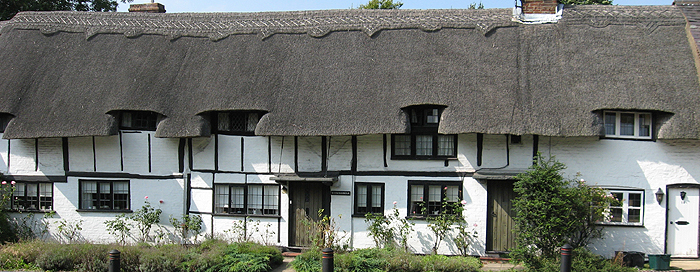
A Guide to Home Insurance & Saving with Online House Insurance Quotes
Thatched Roof Insurance

Non-standard proposals are often best dealt with by specialist home insurers. This is very often the case for properties with thatched roofs.
For mainstream insurers thatched properties can sometimes represent a difficulty to assess due to their non-standard construction, the age of the property and the perceived increased flammability of the thatched roof.
There is an obvious concern that thatched properties are more susceptible to damage by fire. Whether this is the case or not, fires in thatched roofs are far more likely to lead to the loss of the entire roof. Furthermore, many thatched properties are also listed buildings meaning that they must be rebuilt exactly as they were before the fire. The necessity of using qualified craftsmen and traditional materials only adds to the expense. These factors can add up to more expensive insurance premiums for thatched houses.
However, there are steps that can be taken to help minimise the risk of fire in thatched properties, and potentially reduce the cost of insurance premiums.
- The number one cause of fires in thatched roofed cottages is inadequately maintained chimneys. The chimney breast should be swept frequently to prevent the build-up of soot. The brickwork lining the chimney must be inspected regularly by a qualified professional surveyor. If necessary have the chimney completely relined by an accredited builder. Ensure a sufficiently large distance between chimney stack and ridge line (advice on what constitutes a sufficient distance varies so seek professional advice).
- Where woodburning stoves are fitted, though efficient, homeowners must be aware that they do generate extreme heat with a commensurate increase in fire risk. Fit smoke detectors in every room and also in the roof. Consider a specialist chimney alarm which, though expensive, may help reduce your annual home insurance premiums. A spark arrestor may be helpful in reducing the risk of fires started by sparks flying from the chimney, though must be cleaned regularly to avoid the build up of soot and tar (consult your specialist thatch home insurance company or broker for further advice).
- Thatched homes are generally older and this may be true of the electrical wiring if not recently rewired. It is therefore vital to have the electrics checked by a qualified electrician and upgraded wherever necessary. Indeed, some insurers insist on a certified rewiring check as a condition of the policy. Prevent rodent damage by cladding electrical wiring, above all in the roof space.
- In the kitchen locate a fire blanket slightly away from the cooker. Fire extinguishers should be stationed for ease of access. Consider keeping a hose reel permanently on standby capable of reaching all parts of the thatch.
- Clearly any sort of fire in the vicinity of a thatched roof property is a potential hazard. Indoors avoid candles and nightlights. Outside, barbecues, bonfires and fireworks, especially during prolonged dry spells, are best avoided; neighbours should be reminded of the potential dangers.
- A fire retardant barrier fixed between the roof construction and the thatch is certainly an important safety measure and should be fitted if the thatch is being renewed.
- Well maintained thatch, whether water reed (Norfolk Reeds), combed wheat reed (Devon Reeds) or long straw, cannot be ignited as readily as decaying or loose thatch. Seek specialist advice from an experienced time-served thatcher. Do have a proper survey done before buying a thatched house.
A further risk associated with certain types of thatched property is that of infestation by birds or mice. Attracted by the grain left in wheat straw (known also as wheat reed or Devon Reed) in particular, pests can in time create holes in the roof. This problem can be alleviated with a covering of fine wire mesh over the thatch.
Small wonder that applicants for thatched property insurance may find themselves excluded from standard general home insurance policies, or else face premiums with hefty loadings. Often the best place to go for a quote is a broker that specialises in this niche of the market.
As with any policy, it is important to ensure that the sum assured accurately reflects the rebuilding costs. The age and special character of thatched properties means that many are listed buildings. The involvement of English Heritage and the use of traditional craft skills and special materials mean that rebuilding costs can be higher than anticipated. Some specialized policies will allow for this by providing cover up to, for example, 150% of the sum assured providing greater peace of mind for thatched property owners. Remember that for buildings insurance you are insuring for the cost of re-building, not for the market value which includes the value of the land.
Thatch as a roofing material has been in long term decline, but recently it has undergone something of a renaissance in new build houses. Local planning authorities are now more likely to grant planning approval for new thatched homes. Also, improved building regulations have lead to a decreased risk of fire, reflected in more competitive insurance quotes. Today chimneys are cement rather than brick lined, protective fire retardant board is used to line the rafters and fireproof cables are used for all electrical wiring.
Subsidence
Flooding
Problems
Thatched Roof
Flat Roof
Listed Building
Unoccupied
Conservatory
Buy To Let
Making A Claim
Glossary
History
Case Studies
Contact
Copyright © houseinsurance-quotes.co.uk | Privacy & Cookies | Terms
Information supplied here does not constitute advice or a recommendation of a particular house insurance product





